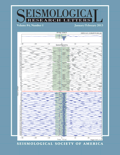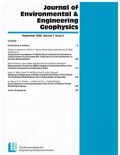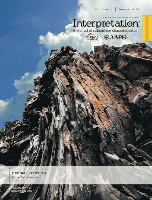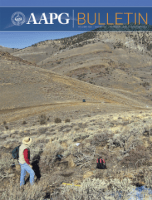
JOURNAL OF SEISMIC EXPLORATION
metrics 2024
Exploring the Depths of Earth with Precision
Introduction
JOURNAL OF SEISMIC EXPLORATION, published by GEOPHYSICAL PRESS, is an esteemed academic journal specializing in the intricate fields of geochemistry and geophysics, focusing on the seismic methods of subsurface exploration. Established in 1992 and operational through 2023, this journal provides a critical platform for researchers, professionals, and students to disseminate high-quality findings related to seismic technologies, exploration techniques, and the interpretation of geophysical data. Although it currently holds a Q4 quartile ranking in both geochemistry and geophysics, the journal remains committed to fostering innovative research that advances the understanding of Earth processes. While not available in an open-access format, the journal offers professional insights and calculates its impact through its dedicated readership and contributions, thereby enhancing the ongoing dialogue in the Earth sciences community. Located in Castelnau-le-Lez, France, this journal is an essential resource for those seeking to deepen their expertise in seismic exploration and its applications.
Metrics 2024
 0.23
0.23 0.30
0.30 0.40
0.40 29
29Metrics History
Rank 2024
Scopus
IF (Web Of Science)
JCI (Web Of Science)
Quartile History
Similar Journals

SEISMOLOGICAL RESEARCH LETTERS
Advancing seismic science for a safer tomorrow.SEISMOLOGICAL RESEARCH LETTERS is a leading journal in the field of geophysics, published by the Seismological Society of America. With its ISSN 0895-0695 and E-ISSN 1938-2057, this prestigious publication serves as a vital platform for disseminating groundbreaking research and advancements in seismological science. The journal boasts an impressive Q1 categorization in the 2023 rankings and ranks 23rd out of 165 in Earth and Planetary Sciences, Geophysics, placing it within the 86th percentile among its peers. Spanning an illustrious history from its origination in 1984 to its ongoing contributions through 2024, it is dedicated to fostering a deeper understanding of seismic phenomena. Although it currently does not offer open access, researchers, professionals, and students can benefit from timely insights and comprehensive studies presented in its pages. Set within the heart of the United States, the journal stands as a cornerstone in geophysics, connecting a global community eager to advance their knowledge and impact in the field.

JOURNAL OF ENVIRONMENTAL AND ENGINEERING GEOPHYSICS
Transforming Knowledge into Action for a Greener PlanetJOURNAL OF ENVIRONMENTAL AND ENGINEERING GEOPHYSICS, published by the ENVIRONMENTAL ENGINEERING GEOPHYSICAL SOC, serves as an essential platform for the dissemination of cutting-edge research in the interconnected fields of environmental engineering, geophysics, and geotechnical engineering. This journal, with the ISSN 1083-1363 and E-ISSN 1943-2658, boasts a solid reputation, reflected in its Q3 rankings in several categories as of 2023. As it converged from 2001 to 2024, the journal has evolved to meet the increasing demand for innovative solutions to contemporary environmental challenges. Researchers are encouraged to submit original articles that contribute meaningfully to our understanding of the subsurface environment and its engineering implications. The journal is indexed in Scopus, with commendable rankings including 72nd out of 165 in Geophysics, highlighting its role in advancing knowledge and application in Earth and Planetary Sciences. Although not an open access journal, subscribers and institutions alike recognize the value of its rigorous peer-reviewed content, ensuring that professionals and scholars are equipped with the latest findings and methodologies in this dynamic field.

Geofisica Internacional
Elevating Research Standards in Geophysics Since 1975Geofisica Internacional, an esteemed academic journal published by the Instituto de Geofísica at UNAM, Mexico's prestigious National Autonomous University, has been a pivotal platform for advancing the field of geophysics and energy studies since its inception in 1975. This Open Access journal aims to disseminate high-quality research findings, making significant contributions to our understanding of Earth's processes and energy resources. With a current impact factor that situates it in the Q3 category for both Energy (miscellaneous) and Geophysics, it provides a continuous dialogue for researchers, professionals, and students interested in the intersection of these critical areas. Based in Mexico City and publishing articles that span various geophysical disciplines, Geofisica Internacional is indispensable for anyone seeking to stay at the forefront of environmental and energy research.

COMPUTATIONAL GEOSCIENCES
Exploring the Intersection of Geosciences and ComputationCOMPUTATIONAL GEOSCIENCES, published by SPRINGER, is a distinguished journal in the fields of Computational Mathematics, Computational Theory and Mathematics, and Computer Science Applications. With a focus on the intersection of computational methodologies and geosciences, this journal serves as a vital platform for researchers, professionals, and students seeking to advance the understanding and application of computational techniques in earth sciences. The journal has consistently maintained a strong standing, evident from its impressive Q2 quartile ranking in 2023 across various categories, and significant Scopus rankings in Computational Mathematics and Earth and Planetary Sciences. The global impact of this journal is underscored not only by its rigorous peer-review process but also by its commitment to disseminating high-quality research that bridges theoretical advances and practical applications within the earth sciences domain. Scientifically rich and culturally diverse, COMPUTATIONAL GEOSCIENCES aims to foster collaboration and innovation while addressing pressing challenges posed by our changing planet, making it an essential resource for the academic community.

STUDIA GEOPHYSICA ET GEODAETICA
Innovating Understanding of Earth's Dynamic SystemsSTUDIA GEOPHYSICA ET GEODAETICA, published by Springer, is a prestigious scientific journal that has been at the forefront of the fields of Geochemistry, Petrology, and Geophysics since its inception in 1957. With an ISSN of 0039-3169 and an E-ISSN of 1573-1626, the journal serves as a vital platform for disseminating original research and reviews that enhance our understanding of the Earth’s processes. Situated in the Netherlands, the journal is indexed in notable databases, holding a respectable Tier Q3 ranking in both Geochemistry and Petrology, as well as Geophysics, based on the 2023 metrics. With its commitment to academic rigor, the journal seeks to engage a diverse audience of researchers, professionals, and students, facilitating vital discourse and advancements in Earth sciences. Although it does not currently offer open access options, it remains a significant resource for those aiming to contribute to or further their knowledge within these critical disciplines.

Interpretation-A Journal of Subsurface Characterization
Bridging Methodologies and Technologies for a Sustainable FutureInterpretation: A Journal of Subsurface Characterization is a premier academic journal dedicated to advancing the methodologies and technologies integral to the characterization of subsurface environments. Published by the Société de l'Exploration Geophysicists (SEG), this journal serves the fields of geology and geophysics, reflecting its critical role in the intersection of these domains. With an h-index that underscores its scholarly impact and its ranking in the Q2 category for both Geology and Geophysics, Interpretation is recognized for publishing high-quality, innovative research that offers valuable insights and solutions to contemporary challenges in subsurface exploration. Since its inception in 2013, the journal has quickly become essential reading for researchers, professionals, and students alike, providing open access to a wealth of knowledge fostering collaboration and advancement within the geoscience community. Featuring a comprehensive range of studies, methodologies, and reviews, Interpretation is integral for professionals striving to enhance their understanding of subsurface dynamics and impacting areas such as resource management, environmental conservation, and hazard assessment.

AAPG BULLETIN
Pioneering research for sustainable energy solutions.AAPG BULLETIN, published by the American Association of Petroleum Geologists, stands as a premier journal in the fields of Earth Sciences and Energy Engineering. With an impressive history spanning from 1968 to 2023, the journal has established itself as a valuable resource for researchers and professionals alike, focusing on a wide array of topics including geology, geochemistry, petrology, and fuel technology. Its robust standing in the academic community is reflected in its recognition as a Q1 journal across multiple categories such as Earth and Planetary Sciences, Energy Engineering, and Geology, with notable rankings in prestigious databases like Scopus. Although not an open-access journal, the AAPG BULLETIN provides vital insights and studies that advance our understanding of Earth processes and energy resources. It serves as an essential platform for disseminating cutting-edge research, fostering collaboration, and inspiring the next generation of scientists and engineers in the pursuit of sustainable energy solutions.

GEOPHYSICAL PROSPECTING
Transforming Geophysical Challenges into SolutionsGEOPHYSICAL PROSPECTING is a premier journal published by Wiley, dedicated to the fields of geophysics and geochemistry. With an impressive impact factor, it holds a notable place in academic circles, boasting a ranking of Q1 in Geophysics and Q2 in Geochemistry and Petrology for 2023. The journal, ISSN 0016-8025 and E-ISSN 1365-2478, features cutting-edge research addressing key challenges in understanding the Earth's structure and processes. It has been an influential platform since its inception in 1953 and continues to converge towards its goal of disseminating integral geophysical advancements through 2024. Although not open access, researchers can benefit from its wealth of high-quality articles, substantiated by commendable rankings of 41st in Geophysics and 53rd in Geochemistry and Petrology. From its headquarters in the United Kingdom, GEOPHYSICAL PROSPECTING not only contributes to the theoretical advancement of these fields but also aids practical applications in environmental exploration and resource management, making it an essential resource for researchers, students, and professionals alike.

Russian Journal of Earth Sciences
Shaping the future of geological understanding.Russian Journal of Earth Sciences, published by the esteemed Geophysical Center RAS, is a pivotal resource for researchers and professionals in the field of Earth and Planetary Sciences. With an ISSN of 1681-1208 and an E-ISSN of 1681-1208, this journal has demonstrated a significant trajectory since its inception in 1998, currently converging towards its 2024 goal of disseminating innovative research. The journal holds a respectable position within the academic community, ranked Q3 in Earth and Planetary Sciences by Scopus, placing it at the 44th percentile among the most relevant journals in the field. Though it operates under a traditional access model, its commitment to advancing scientific knowledge ensures that vital research findings are available to a global audience. Located in Moscow, Russian Federation, the journal not only serves as a platform for high-quality research but also fosters a collaborative environment for scholars aiming to contribute to the understanding of our planet's geological phenomena.

MARINE GEOPHYSICAL RESEARCH
Advancing the frontiers of marine geophysics.MARINE GEOPHYSICAL RESEARCH is a prominent journal published by Springer, dedicated to advancing the field of marine geophysics, with significant contributions to geochemistry, petrology, and oceanography. Established in 1970 and currently running its volumes until 2024, this journal operates as a key resource for researchers and professionals focused on understanding the complexities of marine environments and geological processes. With a strong foothold in academic rankings—positioned in Q2 for both Geophysics and Oceanography, and Q3 for Geochemistry and Petrology in the 2023 category quartiles—MARINE GEOPHYSICAL RESEARCH provides a rigorous platform for high-quality research dissemination. Although not an open-access journal, it offers invaluable insights into marine geophysical phenomena, thus appealing to a diverse audience of scholars and practitioners. The journal’s relevance and impact are further underscored by its Scopus ranks, situating it competitively within the Earth and Planetary Sciences domain. Researchers and students seeking to stay abreast of cutting-edge developments and methodologies in marine geophysics will find it an essential addition to their academic resources.